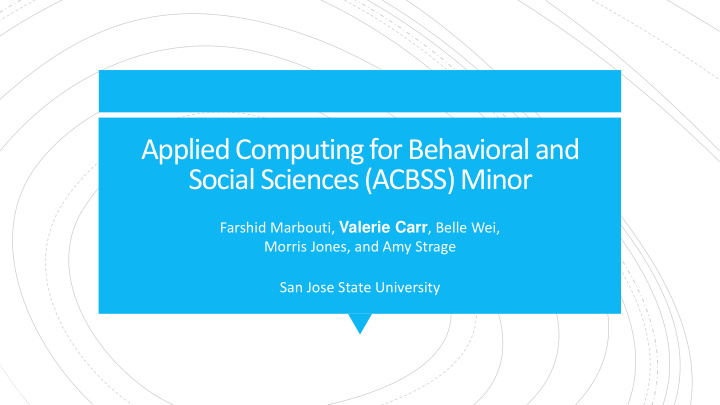



Applied Computing for Behavioral and Social Sciences (ACBSS) Minor Farshid Marbouti, Valerie Carr , Belle Wei, Morris Jones, and Amy Strage San Jose State University
Road map Student recruitment and profile Courses and pedagogical approaches Program assessment Conclusions
Road map Student recruitment and profile Courses and pedagogical approaches Program assessment Conclusions
Why social science students? Tech economy generates vast amounts of data regarding human behavior Growing need for employees with social science knowledge + technical skills
Why social science students? Increase job prospects In the US, social science students account for more than 1 out of 7 bachelor’s degrees (Synder & Dillow, 2012) …. yet they have among the highest unemployment rates of all college grads (Burning Glass Technologies, 2013) Adding technical skills can double the jobs available to them and raise salaries (Burning Glass Technologies, 2013)
Why social science students? Increase diversity in engineering courses Women, African-Americans, and Latinx students are underrepresented in engineering …. and overrepresented in social science majors
Student recruitment Challenges: Students uncertain how programming relates to their interests Assume that tech jobs require extensive programming experience Worried about having low grades on transcript When recruiting… Included info about relevant career opportunities (e.g., user experience research, econometrics, data analysis, etc.) Reassured that class is for social science students only
Student profile Demographic Category College of Engineering ENGR120 (F16, F17, S18) # Students 5,060 113 Gender Female 18% 55.8% Male 82% 44.2% Ethnicity URM 23% 27.4% non-URM 77% 72.6% Majors Psychology N/A 58.4% Economics N/A 19.5% Other N/A 22.1%
Road map Student recruitment and profile Courses and pedagogical approaches Program assessment Conclusions
Interdisciplinary team Courses created by 12 faculty members across several colleges and departments: AVP faculty development Engineering Psychology Economics Political Science
ENGR 120: Programming concepts Intro to Python + applications to the social sciences Basics: Data types, conditionals, iteration, functions, etc. Application: Web scraping, data analysis and visualization Hybrid lecture + lab format Lectures include “Spotlight on ___” and growth mindset concepts
ENGR 121: Data structures & algorithms Build upon and extend Python knowledge Data structures: Classes, trees, graphs, etc. More sophisticated algorithms for data analysis Similar format and pedagogy
ENGR 122: Data technology Intro to R Similarities and differences from Python Focus on data analysis and visualization Similar format and pedagogy
ENGR 195E: Interdisciplinary computing project Culminating experience Student-selected project advised by domain-relevant faculty member Project proposal, regular code reviews and project demos, final paper, presentation
Road map Student recruitment and profile Courses and pedagogical approaches Program assessment Conclusions
Assessment approaches Question: Are we developing pedagogical practices best suited to social science students? Assessments: Pre- and post-course surveys Focus groups with external evaluator
Post-survey: ENGR 120 Students read a series of statements relating to the course, and rated their level of agreement with each 1 = strongly disagree, 5 = strongly agree Data for three semesters: Fall 2016 (39%), Fall 2017 (95%), Spring 2018 (93%)
Interesting Hard Different 5.0 *** 4.5 Overall, enthusiasm was Rating 4.0 high 3.5 3.0 Significant changes over New Career Glad 5.0 time: 4.5 Rating 4.0 Hard 3.5 3.0 Positive environment Connections Positive Envt Community 5.0 Community * 4.5 Rating 4.0 *** 3.5 3.0 p < 0.05 * p < 0.001 F16 F17 S18 F16 F17 S18 F16 F17 S18 ***
Road map Student recruitment and profile Courses and pedagogical approaches Program assessment Conclusions
Conclusions Successfully recruited students whose backgrounds are typically underrepresented in engineering/CS Students found course material challenging but accessible; opened up new career aspirations Future: Incorporate more industry connections (e.g., internships)
Acknowledgments ACBSS students NSF DUE 1626600 Interdisciplinary team: Amy Strage Melinda Jackson David Schuster Belle Wei Evan Palmer Farshid Marbouti Cheryl Chancellor-Freeland Morris Jones Rui Liu Chao Li Tarng Matthew Holian
Questions? valerie.carr@sjsu.edu sjsu.edu/acbss
Introduction to Computing Using Python: An Application Development Focus (2 nd edition)
Focus groups: ENGR 121 & 122 In general, students saw courses as providing unique opportunity to gain valuable knowledge that made them more marketable I'm interested in data analytics and I feel like being in Silicon Valley you need to have some sort of programming experience. My cousin works as a financial analyst, and they require you to have Python and R. She never took these classes and she struggles. I looked at opportunities in the CS department to see if I could take a few courses…they exclude anybody who’s not in their program. This is the only opportunity to do this path with Python.
Quiz wrapper
Recommend
More recommend